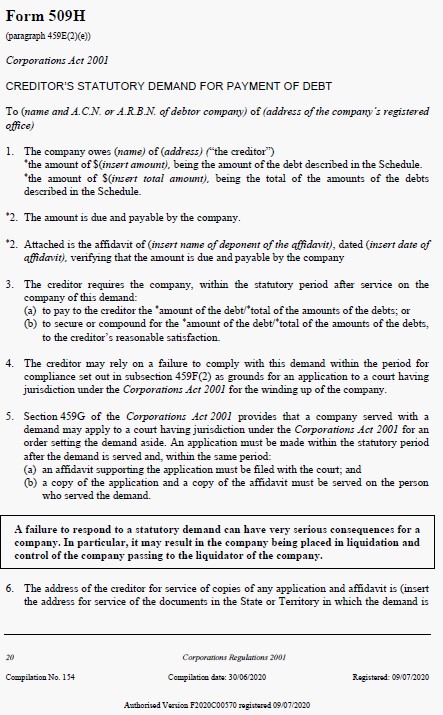
A statutory demand is a procedure used to collect unpaid debts where there is no genuine dispute about the need to pay it. If you are served with a statutory demand then the non-payment (or failure to set aside the statutory demand) can be used to prove the debtor company is insolvent and should be wound up. As you normally have 21 days to respond (except for a six-month period during Covid–19 ) it is critical to move quickly. If, as a company, you suspect creditors are likely to take action make sure to alert your registered office to keep an eye out for a statutory demand so that it is recognised early on and flagged for prompt action.
Buy a PDF Template to Set Aside a Statutory Demand
If you would like to try and set aside a statutory demand on the basis of one of the recognised grounds then you can buy our Template to Set Aside a Statutory Demand to:
- generate pdf documents in draft form including
- draft letter to the creditor
- draft court application (Originating Process) and affidavit in support seeking to set aside the statutory demand.
After your purchase it will be necessary for you to customise and finalise your own application based on the pdf provided. This template is suited to statutory demands served in New South Wales (NSW) and not outside of that state.
What does a statutory demand look like (Form 509H)?
This is what page one of Form 509H (a statutory demand) looks like as at the time of writing:

What other options are there?
A debtor has a number of options when served with a statutory demand:
- it can pay the debt
- it can ask the creditor to withdraw the demand
- it can apply to the court to set aside the demand
All of the above requires prompt action basically 21 days from service (except for a six-month period during the Covid 19 pandemic).
How do you set aside a statutory demand?
- You must make the application within 21 days from being served with a statutory demand unless the changes discussed below applies.
- the application is made to the Supreme Court of New South Wales or to the Federal Court of Australia and on the appropriate court form
- the application to set aside a statutory demand needs to be supported by an affidavit containing certain specified matters including an ASIC search with respect to the debtor company
- the application must be served on the creditor
Recent Changes to Statutory Demands
During the pandemic, basically from about 25 March 2020 until 31 December 2020, the changes are as follows:
- Temporary Statutory thresholds - the debt must be for $20,000 (or more) and the debt must be due and payable.
- Temporary time for compliance - the time for compliance with a statutory demand is increased to 6 months from service of the statutory demand.
(the, "Temporary Measures")
From 1 January 2021 to 31 March 2021, the company can continue to have the benefits of the Temporary Measures if the directors to it make a declaration to ASIC if the debtor company is eligible i.e.
- company debts < $1m;
- there are reasonable grounds to believe company is insolvent (or likely to be so);
- none of the company's directors (within the last 12 months) has been a director of another company that has been under restructuring / simplified liquidation (within last 7 years);
- company has not been under restructuring (within last 7 years);
- board of company resolved that a restructuring practitioner should be appointed;
- there is no restructuring practitioner of the company (or restructuring has not yet terminated); and
- the declaration has not expired;
- etc.
To determine if such a declaration was made consult the ASIC Published Notices. A new statutory demand form will come into operation from 1 January 2021.
On what grounds can you set aside a statutory demand?
The Corporations Act 2001 (Cth) sets out the grounds upon which an application can be made. Essentially, the grounds are as follows:
- where there is a genuine dispute about the debt
- where there is genuine offsetting claim
- if there is a defect in the demand that causes substantial injustice, or
- for some other reason
How much does it cost to set aside a statutory demand?
There are many variables:
- amount of material that needs to be read, understood and then marshalled to put the application together
- the seniority of counsel instructed to appear
- where the application is filed so that Supreme Court is often less expensive when compared with the Federal Court of Australia
- whether there are delays at court in terms of listing the matter and the number of appearances involved
- whether the application is contested or not, and if contested the length of the trial
- if instructions are received outside of normal working hours then additional fees and charges may be incurred because of the urgency of the work
Depending upon what is involved, such applications could easily cost $20,000 (or more) per party and the solicitor will normally require fees upfront and in cleared funds before doing any work. The loser of the application will probably need to pay the legal costs of the winner so there is a chance the costs could exceed $40,000 for the party who loses at court.
Can a winding up petition be issued without a statutory demand?
Yes, if for instance it is not based on a presumption of insolvency arising by reason of non-payment of a statutory demand e.g. a just and equitable winding up of a company.
Most winding up applications are preceded by the non-payment of a statutory demand.
How we assist with setting aside statutory demands
- we explore alternative dispute resolution (provided there is time to do so)
- if there are grounds to do so, we prepare the court application to set aside a statutory demand and assist you with the affidavit to be relied upon in support of the application
- we brief counsel and facilitate a conference with client to progress the preparation for trial

